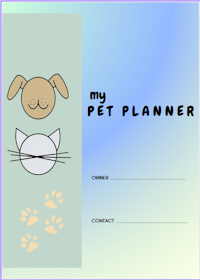Japanese Chin Dog
A Toy Dog Breed With Cat-like Traits
The Japanese Chin dog was previously known at the Japanese Spaniel, but since it bears no relation to a spaniel, its name was later changed.
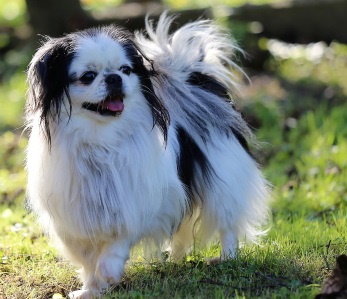
The Chin, as he is often called, is thought to have originated in China, but developed mainly in Japan, specifically for royalty.
How these toy dog breeds arrived there is a matter of debate, though it is speculated that they may have accompanied Chinese monks who migrated to Japan around the 5th century.
Dogs with a strong likeness to the Chin have been seen depicted in ancient artifacts and embroidery found in China, lending support to the early history of this breed.
The Japanese Chin is considered by many to be a descendant of dogs that were revered pets of the Chinese aristocracy.
They are very ornate and compact in appearance with large expressive eyes and a lot of feathering throughout their
substantial coat. Their expression is both exotic, appealing and a little on the proud side.
At one point the Japanese nobility favored a much smaller Chin and gave them Saki to retard their growth. Those that weighed less than three pounds were highly revered as they could fit into the sleeves of kimonos.
In 1854, Japanese Chins that had been secluded in Japan up to that point, were exported out of the country for the first time. Shortly thereafter, Queen Victoria became gifted with two of them.
Later on Queen Alexandra, the wife of
King Edward VII, son of Queen Victoria, received a Chin and became an ardent collector of them. This link to the royal family greatly increased the Chin's popularity in England and Europe.
In 1888, the American Kennel Club (AKC) recognized the Chin under its former name - Japanese Spaniel as part of the toy dog group.
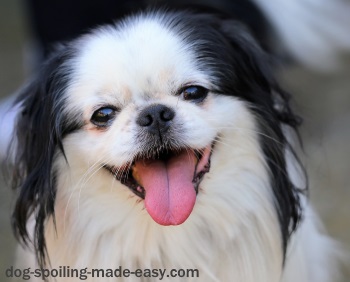
Characteristics of the Japanese Chin Dog
Although the Japanese Chin dog breed seems like the perfect lap dog, it also has a reputation as a very attentive watchdog.
Interestingly, it is one of the quietest dogs and while not a barker, when it does sound the alarm, its bark is surprisingly quite deep and serious sounding.
The Chin is an intelligence dog that can respond to training quite
quickly, but they can also be a bit independent, so consistency is important to let them know you mean business.
That being said, this little dog aims to please and will do well if the training approach is gentle with lots of praise and positive reinforcement methods are used. Chins also are generally quick to catch on to house training as they are a naturally clean breed.
The Japanese Chin is a lap dog to the extent that he loves to be spoiled and snuggled! He is a very affectionate dog and makes a loyal and interesting companion, though he is discerning with strangers.
The Japanese Chin is known for its good-natured, charming and playful temperament. They are quite entertaining and enjoy being around people, often forming strong bonds with their families.
While generally friendly, early socialization is recommended to ensure they are comfortable around new people and other pets.
Supervised playdates with other dogs can be helpful in this regard.
Despite their small size, they have a tendency to take charge so if you have other pets in the home, socialization is especially important.
Overall, they thrive on companionship and love to be involved in family activities.
Health Notes
When it comes to the health of this breed, respiratory and heart conditions are the most common concerns. Because of the brachycephalic flattened short muzzle, they are also more prone to these breathing challenges, as well as overheating, during humid hot weather.
The eyes being on the large side and rather prominent are susceptible to scratches as well as more serious eye conditions. Rolled-in eyelids and cataracts are also somewhat common in the breed.
Inherited genetic issues that can affect the Japanese Chin dog include:
- Luxating patellas a
condition involving the kneecap slipping out of place.
- Heart murmurs.
Other issues include:
- Cataracts
- Epilepsy
- Dental Issues typical with smaller breeds whose teeth can be too crowded.
Regular vet check-ups are important for monitoring the Chin's health to catch any issues early. Preventative care includes vaccination boosters and dental cleanings when necessary.
The Japanese Chin can enjoy a lifespan of 10-12 years with the benefit of a balanced high quality diet, adequate exercise and frequent oversight by a vet professional.
Physical Stats And Care
Height: 7-11 inches
Weight: Up to 7 lbs.
Coat Colors: Black/white or red/white.
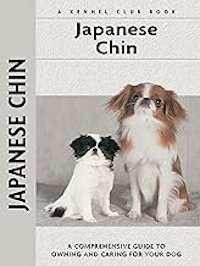

This sturdily built little dog,
with his
profuse feathered tail and expressive eyes, has an aristocratic appearance which seems to reflect his royal heritage.
The Chin is a fastidiously clean dog and has the unusual habit of using its paws - much like a cat - to wash its
face.
Having said that, your help is still required for the largest share of grooming!
The Chin has a very full coat that is straight and silky. To prevent matting and maintain its condition, invest in a good quality boar brush because the coat does need regular brushing and combing almost every day.
While shedding is about average, the dead hair does need to be removed to prevent it turning into a mat.
Bathing the Chin every few months will usually take care of keeping their coat clean and healthy. Trim the nails when necessary to prevent discomfort and avoid mobility issues.
How Active Is The Chin?
This toy dog breed requires almost no daily exercise if allowed to romp freely around the house.
However, while Chins are a relatively a low-energy breed, it is still recommended that they be taken out for short walks because every dog needs to have mental and physical stimulation to maintain good health.
Play sessions are beneficial and interactive toys and games can provide a mental challenge for the intelligent Chin.
Surprise the Chin by changing up his routine or introducing new activities to help prevent boredom.
Also, providing a variety of toys, such as puzzle toys and soft plush ones will keep things interesting for your pup.
Ideal Living Space
The Chin doesn't need a lot of space and doesn't make a lot of noise which fits in very well with apartment living or any other setting.
While they don't require a large yard, a small outdoor space is an advantage for training without distraction, sniffing the bushes and potty breaks.
Chins are sensitive to harsh weather, so avoid taking them out when the weather is bad and/or cold. While indoors, a reasonably comfortable temperature free from drafts is ideal.
The Japanese Chin With Children?
The Chin is a delicate dog and not recommended for active children, but could be a nice pet for a child who is gentle with animals. The Chin does not like rough handling.
Teaching kids how to interact with them respectfully is important.
As always, the best policy
whichever breed of dog you choose, is to have an adult supervise any interaction between children and the household
pets.
Senior Or Less Active Families?
Low exercise demand, loving, loyal, smart and clean makes the Japanese Chin dog the ideal companion for seniors, more sedentary or housebound individuals.
Chins can bring joy and companionship into anyone's life. Their playful antics and very affectionate nature makes them a fun pet to have around.
Handling the grooming needs would be the only variable to consider.
Before You Go...
If you like the content of this page, as well as others on my site, please give it some love by clicking on the heart in the lower right hand corner. This helps me to keep providing enjoyable and useful content.
Thank you.
You Might Also Like
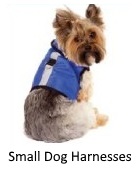 |
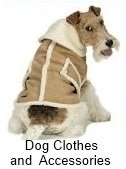
|



